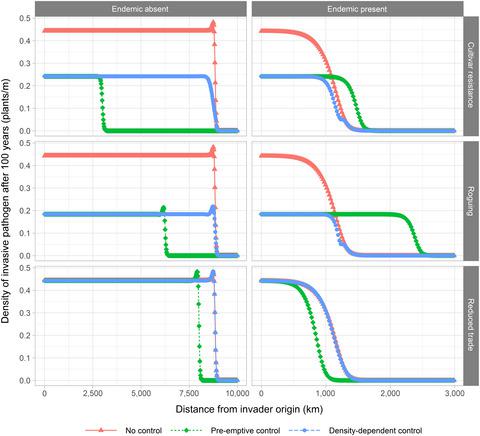当前位置:
X-MOL 学术
›
J. Appl. Ecol.
›
论文详情
Our official English website, www.x-mol.net, welcomes your feedback! (Note: you will need to create a separate account there.)
The effect of competition on the control of invading plant pathogens
Journal of Applied Ecology ( IF 5.7 ) Pub Date : 2020-04-17 , DOI: 10.1111/1365-2664.13618 Ryan T Sharp 1 , Michael W Shaw 2 , Frank van den Bosch 3
Journal of Applied Ecology ( IF 5.7 ) Pub Date : 2020-04-17 , DOI: 10.1111/1365-2664.13618 Ryan T Sharp 1 , Michael W Shaw 2 , Frank van den Bosch 3
Affiliation

|
Abstract New invading pathogen strains must compete with endemic pathogen strains to emerge and spread. As disease control measures are often non‐specific, that is, they do not distinguish between strains, applying control not only affects the invading pathogen strain but the endemic as well. We hypothesize that the control of the invasive strain could be compromised due to the non‐specific nature of the control. A spatially explicit model, describing the East African cassava mosaic virus‐Uganda strain (EACMV‐UG) outbreak, is used to evaluate methods of controlling both disease incidence and spread of invading pathogen strains in pathosystems with and without an endemic pathogen strain present. We find that while many newly introduced or intensified control measures (such as resistant cultivars or roguing) decrease the expected incidence, they have the unintended consequence of increasing, or at least not reducing, the speed with which the invasive pathogen spreads geographically. We identify the controls that cause this effect and methods in which these controls may be applied to prevent it. We found that the spatial spread of the invading strain is chiefly governed by the incidence at the wave front. Control can therefore be applied, or intensified, once the wave front has passed without increasing the pathogen's rate of spread. When trade of planting material occurs, it is possible that the planting material is already infected. The only forms of control in this study that reduces the speed of geographic spread, regardless of the presence of an endemic strain, are those that reduce the amount of trade and the distance over which trade takes place. Synthesis and applications. The best control strategy depends on the presence of competing endemic strains. Applying or intensifying the control can slow the rate of spread when absent but increase it if present. Imposing trade restrictions before the epidemic has reached a given area and intensifying other control methods only when the wave front has passed is the most effective way of both slowing down spread and controlling incidence when a competing endemic strain is present and is the safest approach when its presence is unknown.
中文翻译:

竞争对控制入侵植物病原体的影响
摘要 新的入侵病原体菌株必须与地方性病原体菌株竞争才能出现和传播。由于疾病控制措施通常是非特异性的,即它们不区分菌株,因此应用控制不仅会影响入侵的病原体菌株,还会影响地方病。我们假设由于控制的非特异性性质,可能会损害对侵入性菌株的控制。描述东非木薯花叶病毒-乌干达毒株 (EACMV-UG) 暴发的空间明确模型用于评估在存在和不存在地方性病原体毒株的病理系统中控制疾病发病率和入侵病原体毒株传播的方法。我们发现,虽然许多新引进或强化的控制措施(例如抗性品种或流氓)降低了预期的发病率,它们会产生意想不到的后果,即增加或至少不会减少入侵病原体在地理上的传播速度。我们确定导致这种影响的控制措施以及可以应用这些控制措施来防止这种影响的方法。我们发现侵入应变的空间传播主要受波前的入射影响。因此,一旦波前过去,就可以应用或加强控制,而不会增加病原体的传播速度。当发生种植材料交易时,种植材料可能已经被感染。无论是否存在地方性菌株,本研究中唯一能降低地理传播速度的控制形式是减少贸易量和贸易距离的控制形式。合成与应用。最佳控制策略取决于竞争性地方性菌株的存在。应用或加强控制可以在不存在时减慢传播速度,但如果存在则增加传播速度。在流行病到达特定地区之前实施贸易限制并仅在波前过去时才加强其他控制方法是在存在竞争性地方性菌株时减缓传播和控制发病率的最有效方法,也是最安全的方法存在未知。
更新日期:2020-04-17
中文翻译:

竞争对控制入侵植物病原体的影响
摘要 新的入侵病原体菌株必须与地方性病原体菌株竞争才能出现和传播。由于疾病控制措施通常是非特异性的,即它们不区分菌株,因此应用控制不仅会影响入侵的病原体菌株,还会影响地方病。我们假设由于控制的非特异性性质,可能会损害对侵入性菌株的控制。描述东非木薯花叶病毒-乌干达毒株 (EACMV-UG) 暴发的空间明确模型用于评估在存在和不存在地方性病原体毒株的病理系统中控制疾病发病率和入侵病原体毒株传播的方法。我们发现,虽然许多新引进或强化的控制措施(例如抗性品种或流氓)降低了预期的发病率,它们会产生意想不到的后果,即增加或至少不会减少入侵病原体在地理上的传播速度。我们确定导致这种影响的控制措施以及可以应用这些控制措施来防止这种影响的方法。我们发现侵入应变的空间传播主要受波前的入射影响。因此,一旦波前过去,就可以应用或加强控制,而不会增加病原体的传播速度。当发生种植材料交易时,种植材料可能已经被感染。无论是否存在地方性菌株,本研究中唯一能降低地理传播速度的控制形式是减少贸易量和贸易距离的控制形式。合成与应用。最佳控制策略取决于竞争性地方性菌株的存在。应用或加强控制可以在不存在时减慢传播速度,但如果存在则增加传播速度。在流行病到达特定地区之前实施贸易限制并仅在波前过去时才加强其他控制方法是在存在竞争性地方性菌株时减缓传播和控制发病率的最有效方法,也是最安全的方法存在未知。



























 京公网安备 11010802027423号
京公网安备 11010802027423号